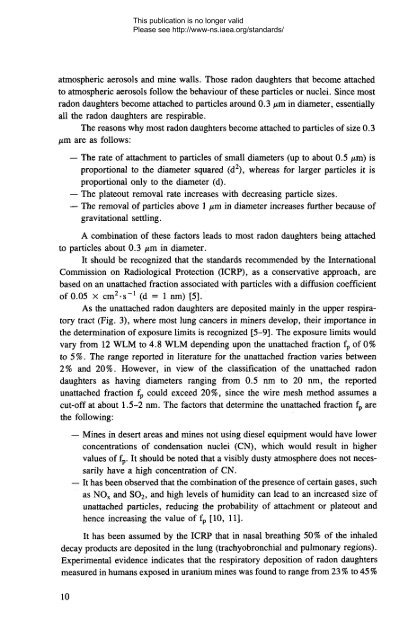IAEA SAFETY GUIDES - gnssn - International Atomic Energy Agency
IAEA SAFETY GUIDES - gnssn - International Atomic Energy Agency
IAEA SAFETY GUIDES - gnssn - International Atomic Energy Agency
You also want an ePaper? Increase the reach of your titles
YUMPU automatically turns print PDFs into web optimized ePapers that Google loves.
This publication is no longer validPlease see http://www-ns.iaea.org/standards/atmospheric aerosols and mine walls. Those radon daughters that become attachedto atmospheric aerosols follow the behaviour of these particles or nuclei. Since mostradon daughters become attached to particles around 0.3 ftm in diameter, essentiallyall the radon daughters are respirable.The reasons why most radon daughters become attached to particles of size 0.3ftm are as follows:— The rate of attachment to particles of small diameters (up to about 0.5 /*m) isproportional to the diameter squared (d2), whereas for larger particles it isproportional only to the diameter (d).— The plateout removal rate increases with decreasing particle sizes.— The removal of particles above 1 /im in diameter increases further because ofgravitational settling.A combination of these factors leads to most radon daughters being attachedto particles about 0.3 /xm in diameter.It should be recognized that the standards recommended by the <strong>International</strong>Commission on Radiological Protection (ICRP), as a conservative approach, arebased on an unattached fraction associated with particles with a diffusion coefficientof 0.05 X cm 2-s _1 (d = 1 nm) [5].As the unattached radon daughters are deposited mainly in the upper respiratorytract (Fig. 3), where most lung cancers in miners develop, their importance inthe determination of exposure limits is recognized [5-9]. The exposure limits wouldvary from 12 WLM to 4.8 WLM depending upon the unattached fraction fp of 0%to 5 %. The range reported in literature for the unattached fraction varies between2% and 20%. However, in view of the classification of the unattached radondaughters as having diameters ranging from 0.5 nm to 20 nm, the reportedunattached fraction fp could exceed 20%, since the wire mesh method assumes acut-off at about 1.5-2 nm. The factors that determine the unattached fraction fp arethe following:— Mines in desert areas and mines not using diesel equipment would have lowerconcentrations of condensation nuclei (CN), which would result in highervalues of fp. It should be noted that a visibly dusty atmosphere does not necessarilyhave a high concentration of CN.— It has been observed that the combination of the presence of certain gases, suchas NOx and S 0 2, and high levels of humidity can lead to an increased size ofunattached particles, reducing the probability of attachment or plateout andhence increasing the value of fp [10, 11].It has been assumed by the ICRP that in nasal breathing 50% of the inhaleddecay products are deposited in the lung (trachyobronchial and pulmonary regions).Experimental evidence indicates that the respiratory deposition of radon daughtersmeasured in humans exposed in uranium mines was found to range from 23 % to 45 %10
















